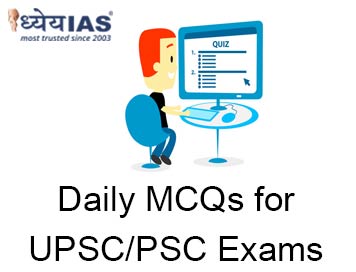Home > Daily-mcqs
Daily-mcqs 06 Aug 2025

Q1:
Match the types of T cells with their respective functions: T cells Works 1. Helper T cells a) Destroy infected or cancerous cells. 2. Cytotoxic (Killer) T cells b) Prevent autoimmune reactions and maintain immune balance. 3. Regulatory T cells c) Assist other immune cells in their function. 4. Memory T cells d) Provide long-term immunity by recognizing previously encountered pathogens. Choose the correct option:
A: 1-c, 2-a, 3-b, 4-d
B: 1-a, 2-b, 3-c, 4-d
C: 1-d, 2-c, 3-a, 4-b
D: 1-b, 2-c, 3-d, 4-a
Answer: A
Explanation:
· Helper T cells assist other immune cells, including B cells and cytotoxic T cells.
· Cytotoxic (Killer) T cells directly destroy infected or cancerous cells.
· Regulatory T cells help prevent autoimmune responses and maintain immune system balance.
· Memory T cells provide long-term immunity by recognizing and responding to pathogens encountered in the past.
Q2:
Consider the following statements regarding the Moidams: 1. The Moidams were added as India's 43rd UNESCO World Heritage Site during the 46th World Heritage Committee session held in 2024. 2. Moidams are royal burial mounds associated with the Mughal period. 3. The Moidams are located in Assam, and their addition to the World Heritage list reflects India’s ongoing efforts to preserve historical sites. Which of the statements given above is/are correct?
A: 1 and 3 only
B: 2 and 3 only
C: 1 only
D: 1, 2, and 3
Answer: A
Explanation:
Q3:
Consider the following statements regarding the UNESCO World Heritage Convention: 1. The World Heritage Convention was adopted in 1972 and aims to preserve both cultural and natural heritage sites of global importance. 2. To qualify as a UNESCO World Heritage Site, a site must meet at least one of the ten criteria, including historical, cultural, and natural significance. 3. India ratified the World Heritage Convention in 1975. Which of the statements given above is/are correct?
A: 1, 2, and 3
B: 1 and 2 only
C: 2 and 3 only
D: All of the above
Answer: B
Explanation:
Q4:
1. It is the largest land tortoise in mainland Asia. 2. Its diet includes leaves, fruits, mushrooms, and decaying plant matter. 3. It is a nocturnal species and prefers to live in dry forests. 4. The tortoise has a lifespan of 10-15 years. Which of the above statements is/are correct?
Consider the following characteristics of the Asian Giant Tortoise (Manouria emys):
A: 1, 2, and 3 only
B: 1 and 2 only
C: 1 and 4 only
D: 2 and 4 only
Answer: B
Explanation:
· Statement 1 is correct. The Asian Giant Tortoise is the largest land tortoise in mainland Asia, reaching sizes up to 60 cm long.
· Statement 2 is correct. Its diet consists of leaves, fruits, mushrooms, and decaying plant matter, reflecting its role as a herbivore in forest ecosystems.
· Statement 3 is incorrect. The Asian Giant Tortoise is diurnal (active during the day) and thrives in humid tropical and subtropical forests, not dry forests.
· Statement 4 is incorrect. The lifespan of the tortoise ranges from 80 to 100 years, making it a long-lived species.
Q5:
1. T Cells are a type of white blood cell that play a crucial role in the immune response by identifying and destroying infected or cancerous cells. 2. Unlike B Cells, which produce antibodies, T Cells have no role in recognizing antigens or pathogens directly. 3. T Cells are produced in the bone marrow and mature in the thymus, where they learn to distinguish between self and foreign antigens. Which of the statements given above is/are correct?
Consider the following statements regarding T Cells:
A: 1 and 3 only
B: 2 and 3 only
C: 1 only
D: 1, 2, and 3
Answer: A
Explanation:
· Statement 1 is correct. T cells are a type of white blood cell that play a central role in immune defense by identifying and destroying infected or cancerous cells.
· Statement 2 is incorrect. T cells do recognize antigens (foreign pathogens), but they do not produce antibodies like B cells.
· Statement 3 is correct. T cells are produced in the bone marrow and mature in the thymus, where they learn to distinguish between self and foreign antigens, a process critical for immune tolerance.